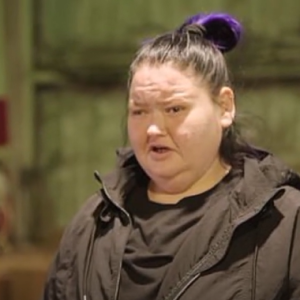From the moment 1000-Lb Sisters graced our screens in 2020, viewers were drawn into the gritty, unvarnished world of Tammy and Amy Slaton—two sisters from small-town Kentucky bound not just by blood, but by a shared struggle that weighed more than just pounds. Their combined weight exceeded 1,000 pounds, but what truly captivated audiences wasn’t just the numbers on a scale, it was the raw, unfiltered humanity behind each gasp for air, each argument, each vulnerable confession. We watched as Amy pursued her dream of motherhood, shedding weight to qualify for surgery, while Tammy spiraled through addiction, hospitalization, and emotional warfare. For every moment of laughter—like the infamous “big girls are beautiful” dance—there was an equally heartbreaking breakdown, a devastating doctor visit, or a tearful realization. As season after season unfolded, what began as a show about weight loss became a chronicle of survival, family dysfunction, and a deeply emotional rollercoaster. And now, with season 8 hanging in the balance, the fans are no longer just passive observers—they are vocal, divided, and passionately invested in what comes next for the Slaton sisters.
Tammy Slaton’s transformation has been nothing short of miraculous, and also gut-wrenching in its intensity. Once facing death in a hospital bed, reliant on oxygen and barely able to speak, she now dances in TikToks, flashes confident smiles, and boasts a jawline sculpted by both surgery and sheer determination. She’s become the ultimate symbol of a phoenix rising, her metamorphosis playing out in real time under the scrutiny of millions. Yet even as the cheers roll in, so do the questions—at what cost has this change come? Fans have begun to scrutinize the ethics behind such raw storytelling. Amy’s own journey has shifted dramatically as well—from hopeful newlywed to overwhelmed mom of two to tearful woman navigating divorce in front of the world. What was once heartwarming has turned harrowing, and by season 7, many longtime fans voiced discomfort at witnessing breakdowns instead of breakthroughs. The tone had shifted. What used to be about healing started to feel like exploitation, with every tear and fight meticulously captured. Viewers began to ask: are we helping them by watching, or are we part of the problem? Was this still empowerment—or emotional erosion?
Still, despite the moral debate, there is an undeniable power in the Slatons’ story. The sisters shattered stereotypes about obesity, class, and resilience. They made space on TV for people long overlooked and silenced. Tammy’s most recent live stream, where she laughed, danced, and teased the possibility of a return, ignited a firestorm of support and speculation. Amy, meanwhile, has chosen silence, focusing on motherhood and posting wistful, cryptic captions like “Whatever happens, no regrets.” Behind the scenes, negotiations are said to be ongoing, with Amy reportedly hesitant to return unless the focus shifts toward positivity and healing. Fans are left in limbo, launching hashtags like #Save1000LbSisters while also begging TLC to let the women go in peace. On Reddit, one fan summed it up perfectly: “I love them too much to keep watching them suffer.” That kind of fandom—the painful, conflicted kind—is rare. It speaks not just to the show’s success, but to the depth of emotional connection forged between the Slatons and their audience. 
TLC now stands at a crossroads. Cancel the show, and they risk silencing two of the most authentic voices reality television has ever known. Renew it as-is, and they risk further criticism and viewer fatigue. But what if there’s a third option? A reinvention. A softer lens. A new season that focuses on wins instead of wounds—Tammy traveling, dating, perhaps launching her rumored wellness brand; Amy thriving as a single mother, maybe even exploring a new love story. Amanda and Chris, fan favorites in their own right, could carry a spin-off exploring body positivity, family life, or even comedic takes on weight loss journeys. Whatever the choice, it needs to reflect growth—both in the subjects and in the production itself. Audiences are no longer satisfied with train wrecks. They want redemption. They want to see the Slatons reclaim their joy, not replay their trauma. Reality TV is evolving, and if 1000-Lb Sisters wants to survive, it too must evolve into something more intentional, more compassionate, more reflective of the real change the sisters have fought so hard to achieve.
In the end, whether Season 8 airs or not, the legacy of 1000-Lb Sisters is already written in the hearts of millions. The show gave us a raw look at pain, but also at perseverance. It forced conversations about addiction, food, family, and the intersection of poverty and health. Tammy and Amy Slaton didn’t just lose weight—they lifted the curtain on a reality so many face and so few see reflected on screen. They became icons not because they were perfect, but because they were brave enough to be imperfect publicly. If they return, it must be on their terms. If they walk away, they do so having already changed the narrative around what it means to be seen, to be vulnerable, and to keep trying even when the world is watching. Because ultimately, the power of their story isn’t measured in ratings or renewals—it’s measured in how deeply it made people feel. And that, no matter what, is worth everything.





